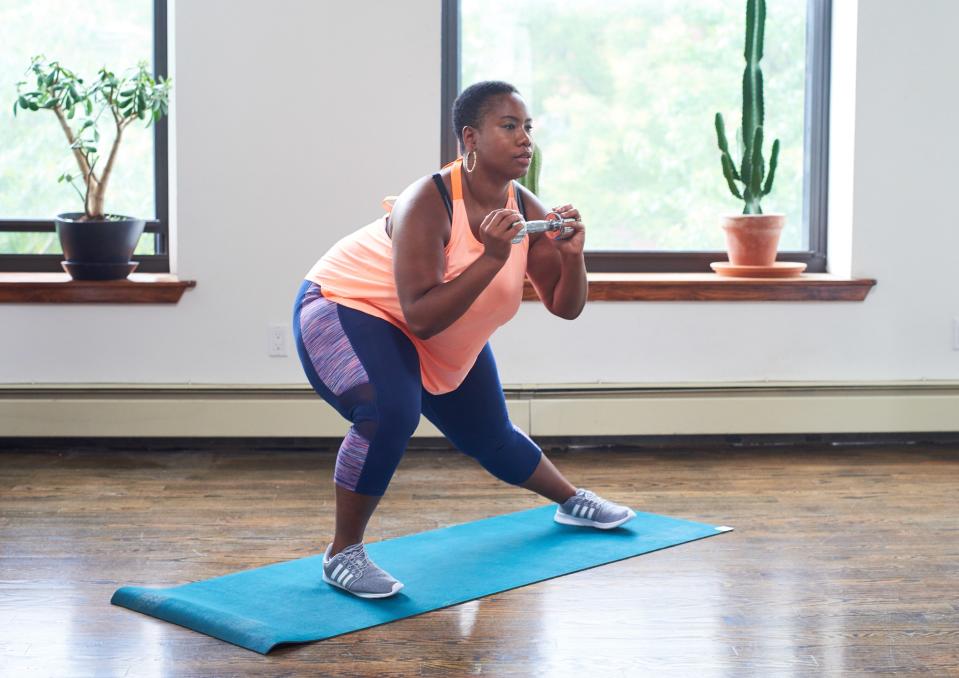How Often Should You Work Out? The Perfect Weekly Workout Routine
We all go into workouts with our own set of goals and expectations, and most of us have wondered how often you should work out. Maybe you run for the mental health benefits. Maybe you lift for the gainz. Maybe you love the serenity of yoga and the aggression of boxing. It's great to hone in on your "why" to motivate you to get up, lace up your sneaks, and get to sweating. But what about the "how"? How often should you work out? And what should you do each time? For how long? Going in with a game plan is crucial. If you've ever asked yourself, "how many days a week should I work out?," you're probably ready for some answers.
That's why we tapped Noam Tamir, CSCS, founder of TS Fitness, to help lay it all out for you.
How often should you work out each week?
As you can imagine, there's no simple formula that's right for everyone. So if you're wondering, "how many days a week should I work out?," that answer might be totally different than, say, your BFF or your coworker. (Come on, you didn't really think the answer would be that easy, did you?) If you're looking to amp up your fitness level, your magic number of days depends on how active you already are. For example, you'll probably see results from one day a week if you don't already work out at all, Tamir says. But if you're used to multiple workout days a week, one day probably won't challenge your body enough to stay at peak form or make progress.
The breakdown varies depending on your specific goals, but in general, four to five days a week will do the trick if you're aiming to improve your fitness and stay in shape.
What should each day of working out look like?
If you want to work out five days per week and are working on both strength and cardiovascular fitness, try three days of strength training, two days of cardio, and two days of active rest. If you only want to work out four days a week, think about your goals: If you want to add muscle, cut a cardio day. If you want to improve endurance, skip a strength day. Or, switch it each week, says Tamir.
Remember, it's important to be realistic about your own schedule when you're asking yourself, "how many times a week should I work out?" If four days makes more sense for you than five days, do that. But if five days is reasonable, great!
Either way, here's how (and when, and why) to crush it at each one.
Strength Training: 2–3 Times per Week

side lunge.jpg
Corey TowersWhy: "The more muscle you have the higher your metabolic rate. It also strengthens joints and bones," he adds.
How: To build muscle mass, you should try to work each muscle group two to three times a week, says Tamir. So in a two- to three-day strength plan, this means you should aim to do full-body workouts—you'll want to hit the major muscle groups of your upper and lower body, including your glutes, quads, hamstrings, chest, shoulders, back, arms, and core. That might sound like a lot, but that's where compound exercises come in. Moves like squats, lunges, and bicep curls-to-overhead presses work more than one muscle group at a time, so you get more bang for your buck. Compound exercises also work your core, so while you can throw in some abs work at the end of a sweat session, you'll also be working your core with every squat (which also works your glutes, hammies, and quads).
You also want to have a balance between pushing and pulling movements. So, for example, a pushing movement would be a chest press, and a pulling movement would be a row. You should do different moves in each of the three strength sessions, but repeat those same moves every week.
"I would stay with a program for four to six weeks and progressively increase the weight," says Tamir. "[The week before your last week], I would have a little bit of a drop-off, to give your body a little bit of a recovery, and the last week really push it hard." Don't feel like you have to go hard on the machines: strength training can also incorporate bodyweight moves (like squats), dumbbells, kettlebells, TRX suspension trainers, and more.
There are also strength training classes available at many gyms and studios: Think TRX classes, CrossFit, and bootcamp-style sessions (like Barry's Bootcamp or Orangetheory, which also incorporate cardio). Challenging barre and reformer Pilates classes can also work your muscles like you wouldn't believe—while these kinds of classes range in intensity (and some are more restorative than others), chances are, there are some in your area that'll seriously put those muscles to the test.
Related: 6 Essential Weight Lifting Moves for Beginners
How Long: A strength-training session should last 45 to 60 minutes, plus foam rolling and at least a quick warm-up beforehand.
Bonus Tip: Strength training is also where you can improve other elements of your fitness. "Flexibility work can be incorporated in the warm-up and during the exercises to make sure you are completing the full range of the movement," says Tamir. You can work on coordination during the warm-up with nonlinear movements and patterns like crawling. You can also improve balance (and engage your core!) by doing single-leg exercises.
Cardio: 2–3 Times per Week

Treadmill run
Sumetee Theesungnern / EyeEmWhy: As important as it is to strength train, cardio has its place in a balanced workout routine too. "Doing cardio keeps your circulatory system working optimally helping you to recover faster…[and it] keeps your endurance up," says Tamir. "It also increases your VO2 max, which helps your body utilize oxygen." Check, check, and check.
How: You've got a ton of options: an outdoor jog, the good old elliptical machine, the list goes on. "Whether something is cardiovascular depends on where your heart rate is at and how long you’re doing it for," says Tamir. Target heart rates are different for everyone, but Tamir suggests that a good baseline to aim for during your cardio routines is between 120 and 150 beats per minute for 45 to 60 minutes. (Learn more about target heart rates here.) "I’m a big fan of doing functional movements to keep my heart rate up," says Tamir. For example, consider kettlebell swings. Often incorporated in strength training, they have their place in a cardio workout too—the key is trying to do more reps within a certain time span to keep that heart rate elevated. And you can improve your agility, while getting in some cardio, with moves used by ice skaters (or by adding an agility ladder).
There are also plenty of cardio classes out there you can drop in on (many of which will work your muscles a bit, too). Heart-pumping examples include indoor cycling, kickboxing, HIIT classes, dance cardio, treadmill classes, rowing classes, and more.
How Long: The American College of Sports Medicine recommends logging 150 minutes of moderate-to-intense activity per week. How you split that up will depend on what type of training you're doing (longer, steady-state sessions vs. shorter HIIT workouts).
Bonus Tip: Another option is interval training, which "helps you burn more calories in the same time as steady state," says Tamir. He likes doing 20 seconds of hard work followed by 40 seconds of active recovery for 45 to 60 minutes. The best part? You can do this with pretty much anything—indoor row machine, bike, treadmill, functional movements, you name it.
Related: 20-Minute Cardio Workout for People Who Hate Running
Rest Days: 2 Times per Week

Shavasana
artursfotoWhy: Taking a break lets your body recover and rebuild so you can get back to your workouts refreshed and ready to rock it. A rest day should actually be considered active recovery, meaning you don't have to hit the gym or break a serious sweat, but you should do something. "It’s not just about the physical recovery—it's also the mental," says Tamir. "Doing something that you enjoy that’s active is great for the mind…and it assists in residual fatigue." Plus, it keeps up your conditioning.
How: Whether you do some stretching or just take a walk, active recovery shouldn't require a ton of effort like a workout day, but it should get you moving. You can also try a restorative class, like gentle yoga or a relaxed mat Pilates class.
How Long: Aim for 30–60 minutes.
Bonus Tip: Where you place these rest days is up to you—if you do your workouts Monday through Friday, feel free to take the whole weekend off, says Tamir. Or, you could break them up by doing a strength day, a cardio day, then a rest day before getting back to weight training. Although the order doesn't really matter, Tamir recommends not working on strength two days in a row. "You want to give your body 48 hours to recover," he says.
Of course, your perfect gym week may vary slightly based on your goals and your schedule, but it's all about having good fitness habits.
"If you want results, you need to have a routine that you can stick with," says Tamir. "I’ve seen so many people try to fit workouts in inconsistently, and it ends up being a waste of time." So, while it's great to have a baseline answer to the question, "how often should you work out?," the most important thing is that it works for you. No matter what you do and when you do it, the goal should be to rock it, rest, repeat.


